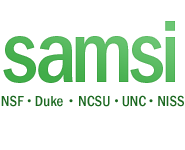Signal Detection for Drug Safety - A Project for IMSM 2012
Mark Wolff
SAS Institute, Inc.
Health and Life Sciences
100 SAS Campus Drive
Cary, NC
Chia Ying Lee
SAMSI
19 T.W. Alexander Drive
Research Triangle Park, NC
Project Description
In 2007 the U.S. Congress passed the Food and Drug Agency Amendments Act which mandated that the FDA develop an automated, electronic safety surveillance system as a means of improving the FDA's ability to protect the public in light of ever increasing drug and device safety concerns. In response to this mandate the FDA created the "Sentinel Initiative". This initiative is based on what the FDA refers to as the emergence of a "Science of Safety" integrating a profound understanding of disease with "new methods of signal detection, data mining, and analysis." The application of advanced and predictive analytics will be critical to the success of this initiative. "Signal Detection" or disproportionality analysis is an important methodology used to predict adverse events associated with specific therapies earlier and with a higher degree of confidence. Although multiple methods of signal detection are presently in use there is great interest on the part of the regulators, the health care community and industry to develop the next generation of signal detection tools. The objectives of this project will be to understand current approaches in signal detection tools and to explore and identify potentially novel or more powerful methods.
References
1. FDA, The Sentinel Initiative: National Strategy for Monitoring Medical Product Safety
2. A.Cami, A. Arnold, S. Manzi and B. Reis, Predicting Adverse Drug Events Using Pharmacological Network Models
